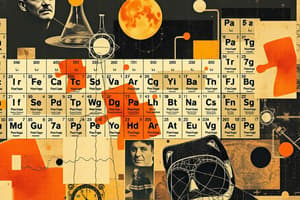Podcast
Questions and Answers
What does the Principal Quantum Number (n) indicate?
What does the Principal Quantum Number (n) indicate?
- The main energy level (correct)
- The orientation of the orbital
- The spin of the electron
- The shape of the orbital
Which statement accurately describes Ionization Potential?
Which statement accurately describes Ionization Potential?
- It is the energy required to remove an electron from an atom. (correct)
- It increases down a group in the periodic table.
- It decreases across a period of the periodic table.
- It is the energy required to add an electron to an atom.
According to Hund's rule, which configuration is more favorable?
According to Hund's rule, which configuration is more favorable?
- Electrons will fill each orbital singly before pairing. (correct)
- Electrons will occupy the lowest available energy orbitals first.
- All orbitals must be completely filled before moving to the next energy level.
- Electrons will pair up in the same orbital before filling others.
What does the Oxidation Number represent?
What does the Oxidation Number represent?
Which Quantum Number indicates the shape of the orbital?
Which Quantum Number indicates the shape of the orbital?
What is the effect of ionization potential as you move across a period in the periodic table?
What is the effect of ionization potential as you move across a period in the periodic table?
Which quantum number is associated with the number of shapes of orbitals within an energy level?
Which quantum number is associated with the number of shapes of orbitals within an energy level?
How does the oxidation number affect the overall charge of a compound?
How does the oxidation number affect the overall charge of a compound?
In which direction does the ionization potential trend decrease in the periodic table?
In which direction does the ionization potential trend decrease in the periodic table?
Which principle states that electrons fill orbitals starting from the lowest energy level to the highest?
Which principle states that electrons fill orbitals starting from the lowest energy level to the highest?
Flashcards are hidden until you start studying
Study Notes
The Modern Periodic Table
- Organized into rows (Periods) and columns (Groups) for systematic classification of elements.
Quantum Numbers
- Principal Quantum Number (n): Represents the main energy level of electrons in an atom.
- Subsidiary Quantum Number (l): Defines the shape of an electron's orbital (s, p, d, f).
- Magnetic Quantum Number (m): Specifies the orientation of the orbital in space.
- Spin Quantum Number (s): Indicates the intrinsic spin of an electron, which can be either +1/2 or -1/2.
Electron Configuration
- Follows specific principles for electron arrangement in atoms:
- Aufbau Principle: Electrons fill orbitals starting from the lowest energy level to higher levels.
- Hund’s Rule: Electrons occupy degenerate orbitals singly before pairing up to minimize repulsion.
Ionization Potential
- Definition: The amount of energy needed to remove an electron from an atom.
- Trend: Ionization potential increases across a period (left to right) and decreases down a group (top to bottom).
Oxidation Number
- Indicates the electric charge of an ion or atom in a compound, which can be positive or negative.
- Reflects the degree of oxidation or reduction an element has undergone in a chemical reaction.
The Modern Periodic Table
- Organized into rows (Periods) and columns (Groups) for systematic classification of elements.
Quantum Numbers
- Principal Quantum Number (n): Represents the main energy level of electrons in an atom.
- Subsidiary Quantum Number (l): Defines the shape of an electron's orbital (s, p, d, f).
- Magnetic Quantum Number (m): Specifies the orientation of the orbital in space.
- Spin Quantum Number (s): Indicates the intrinsic spin of an electron, which can be either +1/2 or -1/2.
Electron Configuration
- Follows specific principles for electron arrangement in atoms:
- Aufbau Principle: Electrons fill orbitals starting from the lowest energy level to higher levels.
- Hund’s Rule: Electrons occupy degenerate orbitals singly before pairing up to minimize repulsion.
Ionization Potential
- Definition: The amount of energy needed to remove an electron from an atom.
- Trend: Ionization potential increases across a period (left to right) and decreases down a group (top to bottom).
Oxidation Number
- Indicates the electric charge of an ion or atom in a compound, which can be positive or negative.
- Reflects the degree of oxidation or reduction an element has undergone in a chemical reaction.
Studying That Suits You
Use AI to generate personalized quizzes and flashcards to suit your learning preferences.




